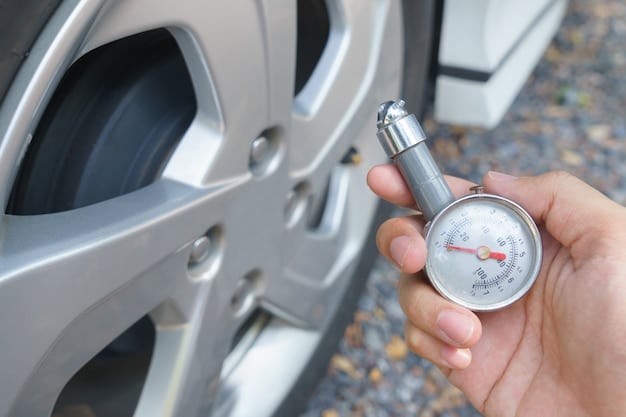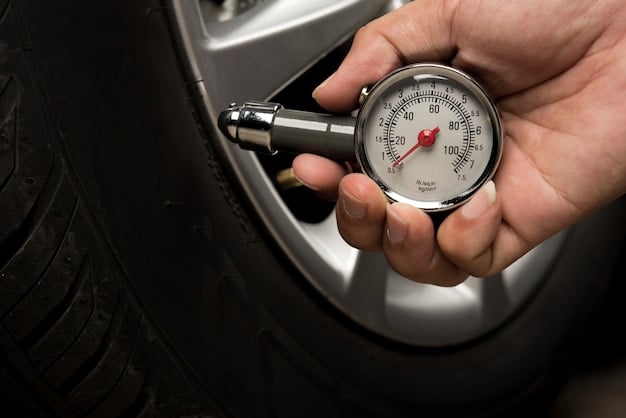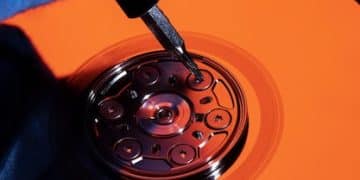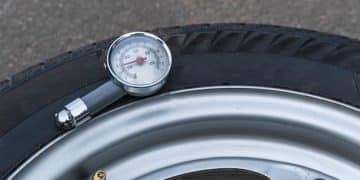Avoid Tire Blowouts: Your Guide to Tire Pressure Monitoring

Avoid tire blowouts by understanding tire pressure monitoring systems (TPMS) and practicing regular maintenance like checking tire pressure, inspecting for damage, and ensuring proper wheel alignment.
Tire blowouts can be a scary and dangerous experience. A sudden loss of tire pressure can cause you to lose control of your vehicle, leading to accidents. This comprehensive guide will arm you with the knowledge to avoid tire blowouts through proper tire pressure monitoring and maintenance, ensuring a safer driving experience.
Understanding Tire Pressure and Its Importance
Maintaining the correct tire pressure is crucial for vehicle safety, performance, and fuel efficiency. Tire pressure directly impacts how your car handles, brakes, and even how much gas you use.
Under-inflated or over-inflated tires can lead to a number of problems, including increased wear and tear, reduced fuel economy, and a higher risk of tire failure. Understanding the optimal tire pressure for your vehicle is the first step in preventing blowouts.
The Impact of Incorrect Tire Pressure
When tires are not inflated to the recommended pressure, several negative consequences can arise. Let’s take a closer look at these impacts:
- Reduced Fuel Efficiency: Under-inflated tires increase rolling resistance, forcing your engine to work harder and consume more fuel.
- Uneven Tire Wear: Incorrect pressure can cause tires to wear unevenly, shortening their lifespan.
- Compromised Handling: Under-inflated tires make your car feel sluggish and less responsive, especially during turns.
Regularly checking and maintaining the correct tire pressure is a simple yet effective way to ensure a safe and efficient driving experience.

Failing to maintain the correct tire pressure can have serious consequences. Correct inflation ensures optimal performance and safety.
Decoding Your Tire Pressure Monitoring System (TPMS)
Modern vehicles are equipped with a Tire Pressure Monitoring System (TPMS), a valuable tool for maintaining optimal tire pressure and preventing blowouts. The TPMS is designed to alert you when your tire pressure falls significantly below the recommended level.
Understanding how your TPMS works and what the warning signs mean can help you take prompt action and avoid potential hazards.
Types of TPMS
There are two main types of TPMS: direct and indirect. Each system uses a different method to monitor tire pressure.
- Direct TPMS: Uses pressure sensors inside each tire to directly measure tire pressure and transmit the data to the vehicle’s computer.
- Indirect TPMS: Relies on the vehicle’s anti-lock braking system (ABS) to monitor tire rotation speed. If a tire loses pressure, its rotation speed increases, triggering a warning light.
Knowing which type of TPMS your vehicle has can help you better understand its capabilities and limitations.
The TPMS is an essential safety feature that can help you detect and address low tire pressure before it leads to a blowout. Pay attention to TPMS warnings and take action promptly.
Essential Tire Maintenance Practices
Beyond monitoring tire pressure, regular tire maintenance is crucial for preventing blowouts and extending the life of your tires. This includes visual inspections, tire rotations, and wheel alignments.
Proactive maintenance can help you identify potential problems early on and address them before they become serious.
Regular Visual Inspections
Make it a habit to visually inspect your tires regularly for signs of damage, wear, and tear. Look for:
- Cuts and Bulges: These can weaken the tire structure and increase the risk of a blowout.
- Uneven Wear: This could indicate misalignment or other mechanical issues.
- Foreign Objects: Remove any nails, screws, or other debris embedded in the tire.
Addressing these issues promptly can prevent them from escalating into more significant problems.

Regular inspections are a simple yet effective way to catch potential problems before they lead to a blowout or other tire-related issues.
Understanding Tire Age and Replacement
Tires, like any other component of your vehicle, have a limited lifespan. Over time, the rubber compound can degrade, even if the tires have plenty of tread remaining. Understanding tire age and knowing when to replace your tires is critical for safety.
Tire age is an often-overlooked factor in tire safety. Even if your tires look fine, they may need to be replaced due to age-related degradation.
How to Determine Tire Age
You can determine the age of your tires by checking the DOT (Department of Transportation) code on the sidewall. The last four digits of the DOT code indicate the week and year the tire was manufactured. For example, a DOT code ending in “1223” means the tire was manufactured in the 12th week of 2023.
As a general guideline, most tire manufacturers recommend replacing tires after six to ten years, regardless of tread depth. However, this can vary depending on factors like climate and storage conditions.
Don’t wait until your tires are bald or showing visible signs of damage to replace them. Knowing the age of your tires and replacing them when necessary is a proactive step in preventing blowouts.
The Role of Professional Tire Services
While you can perform many tire maintenance tasks yourself, professional tire services play a vital role in ensuring the safety and longevity of your tires. These services include tire rotations, wheel alignments, and balance checks.
Professional tire services can help you identify and address potential problems that you might miss during your own inspections.
Benefits of Professional Tire Services
Here’s how professional tire services can contribute to tire safety and performance:
- Tire Rotations: Help ensure even tire wear, extending the life of your tires and improving handling.
- Wheel Alignments: Correct misalignment issues that can cause uneven tire wear and affect steering.
- Balance Checks: Ensure that the weight is evenly distributed around the tire, preventing vibrations and uneven wear.
Consider scheduling regular professional tire services as part of your vehicle maintenance routine. These services can help optimize tire performance and prevent premature wear.
Regular professional tire services complement your own maintenance efforts and can contribute to a safer and more enjoyable driving experience.
Safe Driving Habits to Prevent Tire Blowouts
Ultimately, safe driving habits play a significant role in preventing tire blowouts. Avoiding hazards on the road, maintaining a safe speed, and being mindful of road conditions can reduce the risk of tire damage and failure.
Even with proper tire maintenance, safe driving habits are essential for preventing tire blowouts. Your driving style can significantly impact the stress on your tires.
Tips for Safe Driving
Here are some driving habits that can help prevent tire blowouts:
- Avoid Road Hazards: Steer clear of potholes, debris, and other road hazards that can damage your tires.
- Maintain a Safe Speed: Excessive speed can increase the risk of tire failure.
- Be Mindful of Road Conditions: Adjust your driving to account for wet, icy, or uneven road surfaces.
By practicing these safe driving habits, you can minimize the stress on your tires and significantly reduce the likelihood of a blowout.
Combining proper tire maintenance with safe driving habits is the most effective way to prevent tire blowouts and ensure your safety on the road.
| Key Point | Brief Description |
|---|---|
| 🌡️ Tire Pressure | Maintain recommended pressure for safety and efficiency. |
| 👀 Inspections | Regularly check for cuts, bulges, and uneven wear. |
| 📅 Tire Age | Replace tires every 6-10 years, regardless of tread. |
| 🚗 Safe Driving | Avoid hazards, maintain speed, and adjust to conditions. |
Frequently Asked Questions
▼
It is recommended to check your tire pressure at least once a month and before any long trips. Also, check it when the temperature changes significantly, as this can affect tire pressure.
▼
The correct tire pressure for your car can be found on a sticker located on the driver’s side doorjamb or in your vehicle’s owner’s manual. It is usually listed in PSI (pounds per square inch).
▼
If your TPMS light comes on, check your tire pressure immediately. Inflate any tires that are below the recommended pressure. If the light persists, have your TPMS checked by a professional.
▼
While you can use any tire pressure gauge, it is best to use a reliable and accurate gauge. Digital gauges are generally more accurate than analog gauges. Make sure the gauge is properly calibrated.
▼
Signs of a tire blowout include a sudden loud noise, a noticeable vibration in the steering wheel, and a feeling that the car is pulling to one side. If you experience these signs, safely pull over to the side of the road.
Conclusion
By understanding tire pressure, practicing regular maintenance, and adopting safe driving habits, you can significantly reduce the risk of tire blowouts and ensure a safer driving experience for yourself and others on the road.





